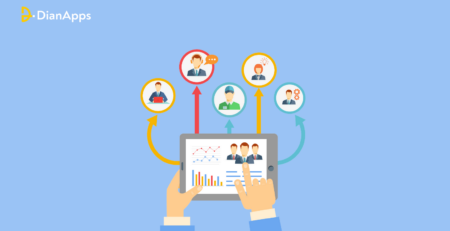From Idea to Execution: Navigating the Software Development Life Cycle
Software development has become an essential aspect of our modern world, powering everything from mobile apps to complex enterprise systems. However, the journey from a simple idea to a fully functional custom software development service is not a straightforward path. It requires careful planning, execution, and adherence to a structured process known as Software Development Life Cycle (SDLC). Navigating this life cycle effectively is crucial for the successful realization of software projects.
In this blog, we will delve into the intricacies of the SDLC and explore the key stages involved in transforming an idea into a tangible software product. Whether you’re a seasoned web app developer or someone new to the world of software development, this guide will provide you with valuable insights and practical knowledge to navigate the entire custom software development benefits and process with confidence.
So, let’s start exploring the Software Development Life Cycle, as we journey from idea to execution, transforming concepts into tangible software products that make a difference in the world.
Understanding the Software Development Life Cycle:

The Software Development Life Cycle (SDLC) is a systematic and structured approach to developing software applications. It provides a framework that guides the entire software development process, from the initial concept to the final deployment and ongoing maintenance. The primary purpose of the SDLC is to ensure the efficient and effective development of high-quality software that meets the needs and requirements of its users.
The SDLC consists of several interconnected phases, each with its own specific goals and activities. While different methodologies and frameworks may have variations in their terminology and sequencing, the core stages of the SDLC generally include:
1. Requirement Gathering:
In this phase, the software app development requirements are identified and documented. It involves understanding the needs and expectations of the stakeholders, defining functional and non-functional requirements, and capturing the scope of the project. This phase lays the foundation for the entire development process and ensures that the software addresses the desired functionalities and goals.
2. Design:
The design phase focuses on creating a blueprint for the software solution based on the requirements gathered. It involves designing the system architecture, database structure, user interface, and other components. This phase helps in visualizing and planning the software’s structure and flow, ensuring that it is scalable, maintainable, and aligned with the project objectives.
3. Development:
Once the design is finalized, the development phase begins, where the actual coding and programming take place. Mobile app developers use programming languages, frameworks, and tools to transform the design into functional software components. This phase requires collaboration among developers, adherence to coding standards, and the implementation of best practices to create robust and reliable software.
4. Testing:
The testing phase is crucial for ensuring the quality and reliability of the software. It involves various types of testing, such as unit testing, integration testing, system testing, and user acceptance testing. Testing identifies and resolves bugs, verifies that the software meets the specified requirements, and ensures that it functions as intended. Thorough testing helps in delivering a stable and error-free software product.
5. Deployment:
After successful testing, the software is ready for deployment. In this phase, the software is released and made available to the end users. It involves activities like configuring the software for the target environment, preparing documentation and user guides, and planning for a smooth transition from development to production. Deployment requires careful coordination and may involve considerations like data migration, hardware infrastructure, and software distribution channels.
6. Maintenance:
Once the software is deployed, the maintenance phase begins. It involves addressing bugs, making enhancements, and providing ongoing support to ensure the software remains reliable, secure, and up-to-date. Maintenance may also include adapting the software to evolving user requirements and technological advancements. This phase aims to maximize the software’s lifespan and value while continuously improving its performance and usability.
The importance of website maintenance of each phase in the SDLC lies in their interconnectedness and their contribution to the overall success of the software project. Neglecting or underestimating any phase can lead to significant issues later on, such as inaccurate requirements, design flaws, coding errors, or inadequate testing. Each phase builds upon the previous one, ensuring that the software aligns with user expectations, and is well-designed, thoroughly tested, and smoothly deployed.
Furthermore, the SDLC helps in managing project timelines, resources, and risks effectively. It promotes collaboration among stakeholders, such as web app developers, project managers, quality assurance teams, and end-users. By following a structured SDLC, organizations can minimize development errors, deliver software solutions on time and within budget, and maintain high standards of quality throughout the software development process.
Phases of Software Development Life Cycle

Phase 1: Ideation and Requirements Gathering
The initial stage of the Software Development Life Cycle (SDLC) sets the foundation for a successful software project. This phase involves ideation, where software ideas are generated and refined, followed by requirements gathering to define the goals, functionalities, and scope of the project.
1. Ideation:
Ideation is the process of generating software ideas and exploring potential solutions to address specific needs or problems. It is a creative and collaborative phase that encourages brainstorming, innovation, and thinking outside the box. Ideation can be inspired by market research, user feedback, emerging technologies, or internal organizational needs.
The importance of ideation lies in its ability to generate unique and valuable software concepts. It helps identify opportunities, uncover user pain points, and envision app development services that can make a meaningful impact. Effective ideation involves fostering a culture of innovation, encouraging diverse perspectives, and leveraging techniques such as mind mapping, ideation workshops, or design thinking.
2. Software Ideas Generation:
To generate software ideas, it is essential to consider various sources of inspiration, such as customer feedback, software development trends, competitor analysis, and emerging technologies. Additionally, seeking input from domain experts, end-users, and stakeholders can provide valuable insights and requirements.
Exploring existing software solutions and identifying their limitations or areas for improvement can also lead to innovative ideas. By studying user experiences and feedback, identifying gaps in the market, and staying updated on technological advancements, software development teams can generate ideas that are both practical and innovative.
3. Requirements Gathering:
Once the initial idea is formed, the next crucial step is to gather and document the requirements. This involves understanding the needs, expectations, and goals of all stakeholders, including end-users, clients, and project sponsors. The aim is to define the functionalities, features, and constraints of the software to ensure it aligns with the desired outcomes.
Effective requirements-gathering techniques include:
- Interviews: Conduct one-on-one interviews with stakeholders to gain a deeper understanding of their needs, preferences, and pain points. This helps uncover implicit requirements that may not be apparent initially.
- Surveys and Questionnaires: Distributing surveys or questionnaires to a larger audience to gather broader feedback, preferences, and insights. This technique allows for quantitative data collection and analysis.
- Prototypes and Mockups: Creating low-fidelity prototypes or mockups to visualize the software’s user interface and interactions. This enables stakeholders to provide more specific feedback and validate the proposed design.
- Workshops and Focus Groups: Organizing collaborative workshops or focus groups involving various stakeholders to encourage active participation, idea sharing, and consensus building. This technique fosters a shared understanding of requirements and promotes effective communication.
The significance of clear and well-defined requirements cannot be overstated. They serve as a blueprint for the software development process, guiding the design, development, and testing activities. They minimize the risk of misunderstandings, scope creep, and rework, leading to efficient project execution, on-time delivery, and customer satisfaction.
Phase 2: Design and Planning
After the ideation and requirements gathering phase, the software development process moves into the second crucial stage: design and planning. In this phase, the software’s architecture, structure, and user interface are carefully planned and designed, laying the groundwork for its successful development.
1. Designing the Software Architecture:
The design phase involves creating a comprehensive architecture for the software solution. This includes defining the overall structure, components, and their interactions. The architecture serves as the foundation for the development process, ensuring scalability, performance, and maintainability.
During this phase, software architects and designers consider factors such as system requirements, technology stack, data storage, security, and integration points. They may use architectural design patterns (e.g., MVC, Microservices) and modeling techniques (e.g., UML diagrams) to visualize and communicate the software’s structure.
2. User Interface (UI) and User Experience (UX) Design:
The UI/UX design services focus on creating an intuitive and user-friendly interface that meets the needs and expectations of the software’s end-users. This involves designing the visual layout, navigation flow, and interactive elements to provide a seamless and engaging user experience.
UI designers consider aspects such as color schemes, typography, icons, and graphic elements to create a visually appealing interface. UX designers focus on understanding user behavior, conducting usability testing, and ensuring the software is easy to navigate, efficient, and meets the users’ goals.
3. Planning the Development Process:
Planning is a critical component of the design phase, as it sets the roadmap for the development process. Project managers and development teams collaborate to define the project scope, timeline, and resource allocation.
Read our best 10-step roadmap to successful app development for startups guide.
During the planning stage, key activities include breaking down the software’s functionalities into smaller tasks, estimating development efforts, identifying dependencies, and allocating resources effectively. Agile methodologies, such as Scrum or Kanban, may be used to manage and track progress.
Additionally, the planning phase may involve setting up version control systems, choosing development tools and frameworks, and establishing coding standards and best practices to ensure consistency and collaboration within the development team.
The importance of the design and planning phase lies in its ability to provide a clear direction for the development team. It minimizes the risk of design flaws, rework, and unnecessary development efforts. A well-designed software architecture ensures scalability, maintainability, and extensibility, while a thoughtful UI/UX design enhances user satisfaction and adoption.
Phase 3: Development and Implementation
Once the design and planning phase is complete, the software development process moves into the third phase: development and implementation. This phase involves translating the design specifications into actual software code, building the software solution, and implementing the planned functionalities.
1. Coding and Development:
The development phase is where the software design is transformed into a functional product through coding. Developers write code according to the specifications defined in the design phase, following coding standards and best practices. This phase may involve multiple programming languages, frameworks, libraries, and tools, depending on the technology stack chosen for the project.
Effective collaboration and communication among the mobile app development company members are crucial during this phase. Clear coding conventions, version control systems, and code reviews help ensure consistency, maintainability, and collaboration within the team. Regular meetings and progress updates facilitate tracking and managing development activities.
2. Iterative Development:
Iterative development methodologies, such as Agile or Scrum, are commonly used during this phase. Instead of attempting to develop the entire software solution in one go, the development is divided into smaller increments or sprints. Each iteration involves developing a set of features, conducting testing, and gathering feedback from stakeholders and end-users.
This iterative approach allows for flexibility and adaptation, enabling the development team to incorporate changes and improvements as the project progresses. It also facilitates early detection of issues, reduces the risk of development divergence, and promotes continuous collaboration and feedback loops.
3. Integration and Testing:
As development progresses, integration and testing become critical activities. Integration involves combining individual software components or modules to create a cohesive and functional system. It ensures that the various parts of the software work together seamlessly.
Testing is performed at multiple levels, including unit testing (testing individual components), integration testing (testing interactions between components), system testing (verifying the software as a whole), and user acceptance testing (validating that the software meets user requirements).
Test-driven development (TDD) and continuous integration (CI) practices are often employed during this phase to ensure code quality and identify and resolve bugs or issues early in the development process. Automated testing frameworks and tools facilitate efficient testing and help maintain the reliability and stability of the software.
4. Documentation:
Throughout the development phase, documentation plays a crucial role. App developers and teams should document the codebase, providing comments, explanations, and instructions that aid in understanding and maintaining the software. Additionally, technical documentation, user manuals, and API documentation are created to assist users and future developers in effectively using and extending the software.
The importance of the development and implementation phase lies in turning the design vision into a tangible software product. By following coding standards, adhering to best practices, and employing effective testing techniques, developers ensure the software’s functionality, stability, and performance.
Furthermore, the iterative development approach allows for incremental progress, feedback incorporation, and early identification of issues, ultimately leading to a higher-quality end product. Documentation provides essential references for maintenance, troubleshooting, and future enhancements.
Phase 4: Testing and Quality Assurance:
The fourth phase of the Software Development Life Cycle (SDLC) is dedicated to testing and quality assurance. In this phase, the software solution is rigorously tested to identify and resolve any defects or issues before its final deployment. Testing ensures that the software meets the specified requirements, functions as intended, and delivers a high-quality user experience.
Types of Testing:
The testing phase encompasses various types of testing to ensure comprehensive coverage and identify different categories of defects. Some common types of testing include:
- Unit Testing: This involves testing individual components or modules of the software to ensure they function correctly in isolation.
- Integration Testing: The focus here is on testing the interactions and interfaces between different components to verify their proper integration and communication.
- System Testing: It involves testing the software as a whole to validate its compliance with the defined requirements and ensure the system functions as intended.
- User Acceptance Testing (UAT): This testing is performed by end-users or stakeholders to ensure that the software meets their expectations and requirements.
- Performance Testing: This type of testing assesses the software’s performance under various load conditions to ensure it can handle expected workloads.
- Security Testing: It involves testing the software’s resilience against potential security vulnerabilities and ensuring it complies with security standards.
- Regression Testing: This is conducted to ensure that changes or fixes made to the software do not introduce new defects or impact existing functionalities.
2. Test Planning and Execution:
The testing phase begins with test planning, where the testing objectives, test scenarios, and test cases are defined. Test plans outline the testing approach, resources required, and the schedule for executing different types of tests.
Test execution involves running the defined test cases and scenarios, observing the software’s behavior, and comparing the actual results with the expected outcomes. Defects and issues identified during testing are logged and prioritized for resolution.
Automated testing tools and frameworks are often utilized to streamline the testing process, improve efficiency, and facilitate the repetition of tests. They help automate repetitive tasks, generate reports, and track testing progress.
3. Defect Management and Resolution:
When defects are identified during testing, they are documented, classified, and assigned to the development team for resolution. A defect management process is established to track the status of each defect, prioritize them based on their impact, and ensure their timely resolution.
The development team investigates the root causes of defects and implements appropriate fixes. The fixed code undergoes retesting to verify that the defects have been effectively resolved without introducing new issues.
4. Quality Assurance:
In addition to testing, quality assurance activities focus on ensuring the overall quality of the software solution. Quality assurance encompasses various practices, including code reviews, static code analysis, adherence to coding standards, and compliance with quality guidelines.
Quality assurance also involves ensuring the software meets non-functional requirements, such as performance, security, usability, and accessibility. By conducting comprehensive reviews and checks, app development companies can identify and rectify issues early, reducing the risk of defects and enhancing the overall quality of the software.
The significance of the testing and quality assurance phase lies in its ability to identify and resolve defects and ensure the software meets the defined quality standards. Rigorous testing minimizes the risk of software failures, enhances reliability, and improves the user experience. It also contributes to the credibility of the software and the organization delivering it.
Phase 5: Deployment and Release
In this phase, the developed and tested software solution is deployed into the production environment, made available to end-users, and actively maintained to ensure its optimal performance and continued functionality.
1. Deployment Planning:
Before deploying the software, a thorough deployment plan is developed to ensure a smooth transition from the development environment to the production environment. The plan outlines the steps, resources, and timeline required for a successful deployment.
Considerations in the deployment plan include infrastructure setup, data migration, configuration management, and any necessary user training or documentation updates. Collaboration between the development, operations, and infrastructure teams is crucial to ensure all technical aspects are properly addressed.
2. Production Deployment:
During the deployment phase, the software solution is deployed to the target production environment. This may involve installing the software on servers, configuring databases, setting up network connections, and performing any necessary integrations with existing systems.
Deployment processes may vary depending on the nature of the software and the infrastructure in use. Continuous integration and continuous deployment (CI/CD) practices can automate the deployment process, ensuring consistency and reducing the risk of human error.
3. Post-Deployment Testing:
After the software is deployed, additional testing is often performed in the production environment to ensure its functionality and performance. This includes validating that all components are functioning as expected, data is being processed correctly, and the software development services operate seamlessly in their intended environment.
Performance monitoring tools and techniques are employed to monitor system behavior, identify potential bottlenecks, and optimize the software’s performance. Any issues or bugs identified during post-deployment testing are addressed promptly through bug fixes or updates.
4. Maintenance and Support:
The maintenance phase involves ongoing support and maintenance activities to ensure the software’s smooth operation and address any issues that arise. This includes providing technical support to end-users, monitoring the software’s performance, and applying updates or patches as needed.
Maintenance activities also encompass bug fixes, security patches, and enhancements to address changing user requirements or technology advancements. Regular backups, disaster recovery plans, and system monitoring are established to minimize downtime and ensure data integrity.
Maintenance tasks may be categorized into corrective maintenance (fixing defects or issues), adaptive maintenance (making changes to accommodate evolving needs), perfective maintenance (optimizing performance and usability), and preventive maintenance (proactively identifying and resolving potential issues).
5. User Support and Training:
During the maintenance phase, user support and training are provided to assist end users in effectively utilizing the software. This includes addressing user queries, providing documentation and user guides, conducting training sessions, and ensuring ongoing communication channels for user feedback and support requests.
Regular user feedback is valuable for identifying areas of improvement and capturing feature requests or usability concerns. User support and training contribute to user satisfaction, adoption, and the long-term success of the software.
The deployment and maintenance phase ensures that the software app development solution remains functional, secure, and up-to-date throughout its lifecycle. It involves ongoing monitoring, updates, and support to meet user needs and maintain the software’s performance and reliability.
Phase 6: Evaluation and Continuous Improvement:
The sixth and final phase of the Software Development Life Cycle (SDLC) is the evaluation and continuous improvement phase. This phase involves assessing the performance of the software solution, gathering feedback from users and stakeholders, and implementing enhancements or updates to improve its functionality and effectiveness.
1. Performance Evaluation:
In the evaluation phase, the software solution’s performance is assessed against the defined objectives and key performance indicators (KPIs). This involves analyzing metrics such as response time, scalability, reliability, and user satisfaction.
Performance evaluation can be conducted through various means, including surveys, user feedback, analytics, and monitoring tools. The gathered data provides insights into how well the software is meeting user needs and if any areas require improvement.
2. User Feedback and Satisfaction:
Collecting feedback from end-users and stakeholders is crucial to understanding their experiences and identifying potential areas of improvement. Surveys, interviews, focus groups, and user testing sessions use ato gather feedback on the software’s usability, functionality, and overall satisfaction.
User feedback serves as a valuable resource for identifying pain points, uncovering new requirements, and determining potential enhancements. By actively engaging with users, organizations can gain insights that drive iterative improvements to the software solution.
3. Continuous Improvement:
Based on the evaluation and feedback received, organizations can prioritize and implement continuous improvements to the software. This may involve bug fixes, performance optimizations, feature enhancements, or updates to address evolving user requirements or technological advancements.
Continuous improvement enables achievement through agile development methodologies, where feedback integrates into development cycles regularly. The use of version control systems, issue-tracking tools, and agile project management practices facilitates effective collaboration and streamlines the implementation of enhancements.
4. Documentation and Knowledge Sharing:
As updates and improvements are adaptive to the software, it is crucial to document the changes for future reference and knowledge sharing. This includes updating technical documentation, user guides, and training materials to reflect the latest version of the software.
Documentation ensures that the software remains well-documented and understandable, aiding in future maintenance, troubleshooting, and employee onboarding software to hire new team members. It also promotes knowledge sharing within the organization and helps maintain consistency in the software’s development and evolution.
5. Stakeholder Communication:
Throughout the evaluation and continuous improvement phase, maintaining open and transparent communication with stakeholders is vital. Regular updates, progress reports, and discussions keep stakeholders informed about the software’s performance, enhancements, and future plans.
Stakeholder input is invaluable for aligning the software with business goals, addressing their specific needs, and obtaining buy-in for further improvements. By involving stakeholders in the evaluation and improvement process, organizations can foster a collaborative and customer-centric approach to software development.
The evaluation and continuous improvement phase ensure that the software solution remains aligned with the evolving needs of the users and the organization. By actively seeking feedback, implementing enhancements, and maintaining open communication, organizations can maximize the value and relevance of the software over its lifecycle.
Wrapping Up
Mastering the software development life cycle is crucial for successful software project execution.
By following the phases/stages discussed and partnering. With a leading software development company like DianApps, organizations can navigate the SDLC with confidence. This may result in the development of exceptional software solutions that meet user needs, drive business growth, and achieve sustainable success.
Whether it’s ideation, requirements gathering, development, testing, deployment, maintenance, or continuous improvement, DianApps, being the renowned best website development company in the USA, understands the importance of each phase in the SDLC.
We work closely with clients to understand their unique requirements. To provide expert guidance throughout the development process. And also deliver tailor-made solutions that align with business objectives.




